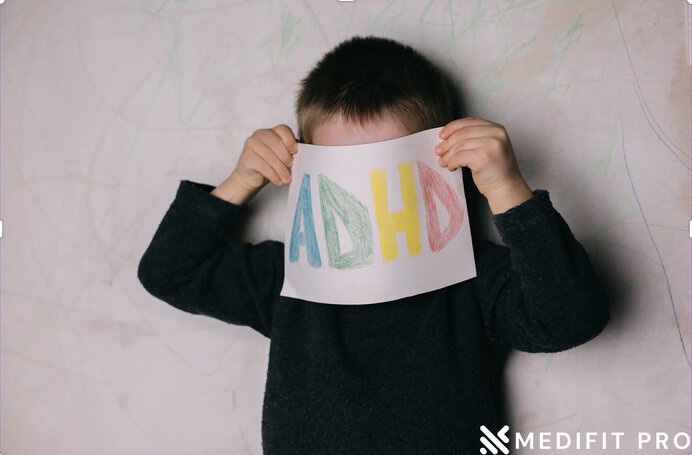Attention Deficit Hyperactivity Disorder, commonly referred to as ADHD, is a neurodevelopmental disorder that affects millions of people worldwide. It is characterized by symptoms such as hyperactivity, impulsivity, and inattention, which can significantly impact an individual’s daily life.
According to the Centers for Disease Control and Prevention (CDC), approximately 6.1 million children in the United States have been diagnosed with ADHD, with a prevalence rate of 9.4% in children aged 2-17 years. The impact of ADHD goes beyond childhood, with up to 60% of children with ADHD continuing to experience symptoms into adulthood.
Understanding ADHD is critical, not just for those diagnosed with the disorder but also for their families, friends, and society at large. ADHD can lead to difficulties in academic and occupational settings, strained relationships, and mental health issues such as anxiety and depression. However, with the right treatment and support, individuals with ADHD can thrive and reach their full potential.
In this article, we’ll explore the causes, symptoms, impacts, and treatment options for ADHD. We’ll also examine the differences between ADHD in children and adults, and provide practical strategies for coping with ADHD. By the end of this article, you’ll have a better understanding of ADHD and how to support those affected by it.
II. Causes and Symptoms of ADHD
ADHD is a neurodevelopmental disorder that can be caused by a combination of genetic and environmental factors. Research has shown that genetics play a significant role in the development of ADHD, with up to 80% of cases having a hereditary component. However, environmental factors such as prenatal exposure to toxins, low birth weight, and maternal smoking during pregnancy have also been linked to ADHD.
Here are some of the main causes of ADHD:
A. Genetic Factors
1. The role of genetics in ADHD development
2. The genetic link between parents and children with ADHD
3. The role of epigenetics in ADHD development
B. Environmental Factors
1. The impact of toxins and pollutants on ADHD development
2. The effects of maternal smoking and alcohol consumption on ADHD development
3. The role of prenatal and perinatal complications in ADHD development
The symptoms of ADHD can have a significant impact on an individual’s daily life, affecting their academic and occupational performance, as well as their social relationships. The three primary symptoms of ADHD are inattention, hyperactivity, and impulsivity.
Here are some of the main symptoms of ADHD:
A. Inattention Symptoms
1. Difficulty paying attention to details and maintaining focus
2. Easily distracted and forgetful
3. Difficulty completing tasks and following instructions
B. Hyperactivity Symptoms
1. Restlessness and fidgeting
2. Excessive talking and interrupting others
3. Difficulty engaging in quiet activities
C. Impulsivity Symptoms
1. Acting without thinking and engaging in risky behaviors
2. Difficulty waiting their turn and interrupting others
3. Difficulty controlling emotions and reactions
Diagnosis of ADHD
Diagnosing ADHD can be challenging and requires a comprehensive evaluation by a healthcare professional. The American Psychiatric Association’s Diagnostic and Statistical Manual of Mental Disorders (DSM-5) provides a list of criteria that must be met for a diagnosis of ADHD. These criteria include the presence of symptoms for at least six months, the onset of symptoms before the age of 12, and impairment in at least two settings (e.g., home and school).
Here are some important factors to consider when diagnosing ADHD:
1. The importance of a comprehensive evaluation by a healthcare professional
2. The use of rating scales and other tools to assess ADHD symptoms
3. The need to rule out other potential causes of ADHD-like symptoms, such as anxiety or depression
III. Impacts of ADHD
Attention-deficit/hyperactivity disorder (ADHD) can have significant impacts on an individual’s life, affecting their academic and occupational performance, social relationships, and mental health. The symptoms of ADHD, including inattention, hyperactivity, and impulsivity, can make it challenging to manage day-to-day tasks and responsibilities. Here are some of the main impacts of ADHD:
A. Educational and Occupational Difficulties
1. Challenges with completing tasks and assignments on time
2. Difficulty paying attention and following instructions in a classroom or work setting
3. Lower academic and occupational performance and achievement
B. Social and Relationship Challenges
1. Difficulty making and maintaining friendships
2. Tendency to interrupt or talk excessively, leading to social isolation and exclusion
3. Higher rates of conflict and misunderstandings in personal relationships
C. Mental Health Issues Associated with ADHD
1. Increased risk of developing anxiety and depression
2. Higher rates of substance abuse and addiction
3. Increased risk of developing conduct disorder or oppositional defiant disorder
D. Strategies for Managing the Impacts of ADHD
The impacts of ADHD can be challenging to manage, and individuals with ADHD often require support and intervention to succeed in their personal and professional lives. Treatment for ADHD typically involves a combination of medication and behavioral therapy, with the goal of improving attention, reducing hyperactivity, and managing impulsivity.
Here are some strategies for managing the impacts of ADHD:
1. Working with a healthcare professional to develop a personalized treatment plan
2. Developing strategies for managing time and tasks, such as creating a schedule and breaking down assignments into smaller tasks
3. Engaging in regular physical exercise and mindfulness practices to reduce stress and improve attention
IV. Treatment and Management of ADHD
ADHD is a treatable disorder, and early diagnosis and intervention can significantly improve an individual’s outcomes. The treatment for ADHD typically involves a combination of medication and behavioral therapy, with the goal of improving attention, reducing hyperactivity, and managing impulsivity. Here are the main types of treatments used for ADHD:
A. Medications Used to Treat ADHD
1. Stimulant medications such as Ritalin and Adderall, which are known to improve attention and reduce hyperactivity
2. Non-stimulant medications such as Strattera, which can improve attention and reduce impulsivity without the risk of abuse or addiction
3. Antidepressant medications such as Wellbutrin, which can improve mood and reduce symptoms of ADHD
B. Behavioral Therapies and Interventions
1. Cognitive-behavioral therapy, which can help individuals with ADHD develop coping skills and strategies for managing symptoms
2. Parent training and education, which can help parents better understand and support their child with ADHD
3. Classroom accommodations and modifications, such as preferential seating and modified assignments, which can improve academic performance
C. Alternative Treatments for ADHD
1. Mindfulness practices such as meditation and yoga, which can help reduce stress and improve attention
2. Dietary changes such as eliminating certain foods and additives, which may exacerbate symptoms in some individuals
3. Herbal supplements such as ginkgo biloba and omega-3 fatty acids, which have shown some promise in improving attention and reducing hyperactivity
It’s important to note that while alternative treatments for ADHD may have some benefit, they should not be used as a replacement for evidence-based medical and behavioral treatments. It’s essential to work with a healthcare professional to develop a personalized treatment plan that considers all available options and the individual’s unique needs and preferences.
V. ADHD in Children vs. Adults
Differences in Symptoms and Diagnosis
ADHD is often diagnosed in childhood, but many adults may not receive a diagnosis until later in life. Children with ADHD typically exhibit symptoms such as hyperactivity, impulsivity, and inattention. They may have difficulty sitting still, completing tasks, and following instructions. Children with ADHD may also struggle with social interactions and have difficulty making and keeping friends.
In contrast, adults with ADHD may not exhibit the same hyperactive or impulsive behaviors that are common in children with ADHD. Instead, they may have difficulty with organization, time management, and task completion. Adults with ADHD may also struggle with maintaining focus and may have difficulty with memory and recall.
Challenges Faced by Adults with ADHD
Adults with ADHD often face a unique set of challenges that can impact their personal and professional lives. They may struggle with time management and organization, which can lead to difficulty meeting deadlines or completing tasks. Adults with ADHD may also experience difficulty with decision-making and impulsivity, which can impact their relationships and financial stability.
Adults with ADHD may also experience challenges in the workplace. They may have difficulty with concentration and staying on task, which can impact their productivity. Additionally, they may struggle with social interactions and communication, which can impact their ability to work collaboratively with others.
Impact of ADHD on Relationships and Parenting
ADHD can also impact relationships and parenting. Children with ADHD may struggle with social interactions and have difficulty making and keeping friends. They may also have difficulty with academic performance and completing tasks. Parents of children with ADHD may experience additional stress and may need to provide additional support to their child.
In contrast, adults with ADHD may experience challenges in romantic relationships and friendships. They may struggle with communication and may have difficulty managing their emotions, which can lead to conflict. Additionally, adults with ADHD may face challenges in parenting their own children, as they may struggle with consistency and organization.
VI. Coping with ADHD
Attention Deficit Hyperactivity Disorder (ADHD) can be a challenging condition to manage, but with the right strategies and support, individuals with ADHD can learn to cope and thrive. In this article, we will discuss effective strategies for managing ADHD symptoms, tips for parents and caregivers, and resources for those living with ADHD.
Strategies for Managing ADHD Symptoms
Managing ADHD symptoms can be challenging, but there are effective strategies that can help individuals with ADHD live a more productive and fulfilling life. Here are a few strategies to consider:
1. Medication: Medication can be an effective treatment for ADHD. Talk to your doctor about the best medication options for you.
2. Behavioral therapy: Behavioral therapy can help individuals with ADHD learn coping strategies, improve social skills, and reduce impulsive behaviors.
3. Exercise: Exercise can help reduce symptoms of ADHD by improving focus, reducing stress, and increasing dopamine levels in the brain.
4. Mindfulness meditation: Mindfulness meditation can help individuals with ADHD reduce stress, improve focus, and increase self-awareness.
5. Time management: Developing effective time management strategies can help individuals with ADHD stay organized, manage their time more efficiently, and reduce stress.
Tips for Parents and Caregivers
Parents and caregivers can play an important role in supporting individuals with ADHD. Here are a few tips for parents and caregivers:
1. Establish a routine: Creating a routine can help individuals with ADHD stay organized and manage their time more effectively.
2. Provide positive reinforcement: Positive reinforcement can help individuals with ADHD build self-confidence and reduce negative behaviours.
3. Set clear expectations: Setting clear expectations can help individuals with ADHD understand what is expected of them and reduce confusion.
4. Communicate effectively: Effective communication can help individuals with ADHD feel heard and understood.
Resources for Those Living with ADHD
There are many resources available for individuals with ADHD, including support groups, educational programs, and online resources. Here are a few resources to consider:
1. CHADD (Children and Adults with Attention-Deficit/Hyperactivity Disorder): CHADD is a nonprofit organization dedicated to improving the lives of individuals with ADHD.
2. ADDitude Magazine: ADDitude is a magazine and website that provides information and resources for individuals with ADHD.
3. National Institute of Mental Health: The National Institute of Mental Health provides information on ADHD research and treatment.
4. Your local support groups: There may be local support groups for individuals with ADHD in your area. Check with your doctor or community center to find a group near you.
VII. Conclusion
In conclusion, we have discussed the key differences in symptoms and diagnosis of ADHD in children vs. adults, as well as the challenges faced by adults with ADHD and the impact of ADHD on relationships and parenting. We have also discussed effective strategies for managing ADHD symptoms, tips for parents and caregivers, and resources for those living with ADHD.
It is important to remember that seeking professional help and support is crucial for individuals with ADHD. Whether it’s through medication, behavioral therapy, or support groups, there are resources available to help individuals with ADHD manage their symptoms and live a fulfilling life.
Living with ADHD can be difficult, but there is hope. With the right strategies and support, individuals with ADHD can learn to cope and thrive. By establishing routines, developing effective time management strategies, and utilizing resources like support groups and educational programs, individuals with ADHD can overcome the challenges they face and lead a successful life.
Also read Children’s Mental Health is More Important Than Ever Now
Reference
- National Institute of Mental Health (NIMH): https://www.nimh.nih.gov/health/topics/attention-deficit-hyperactivity-disorder-adhd/index.shtml


























Recent Comments